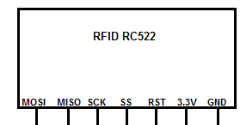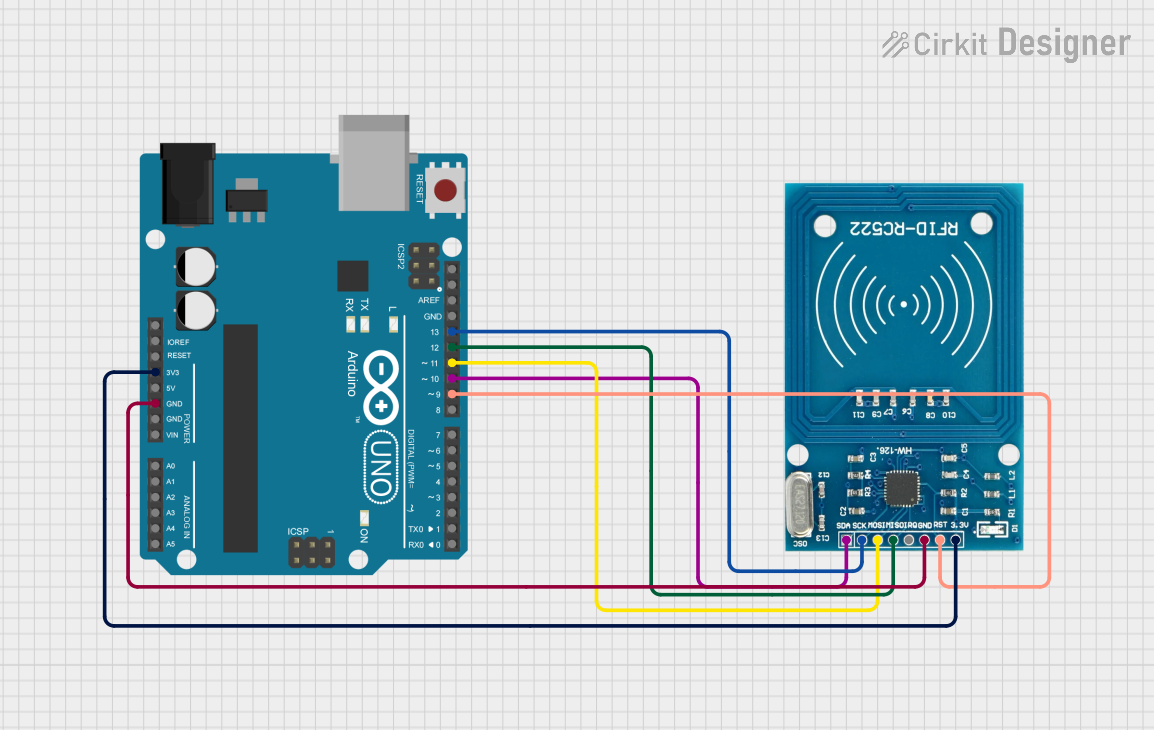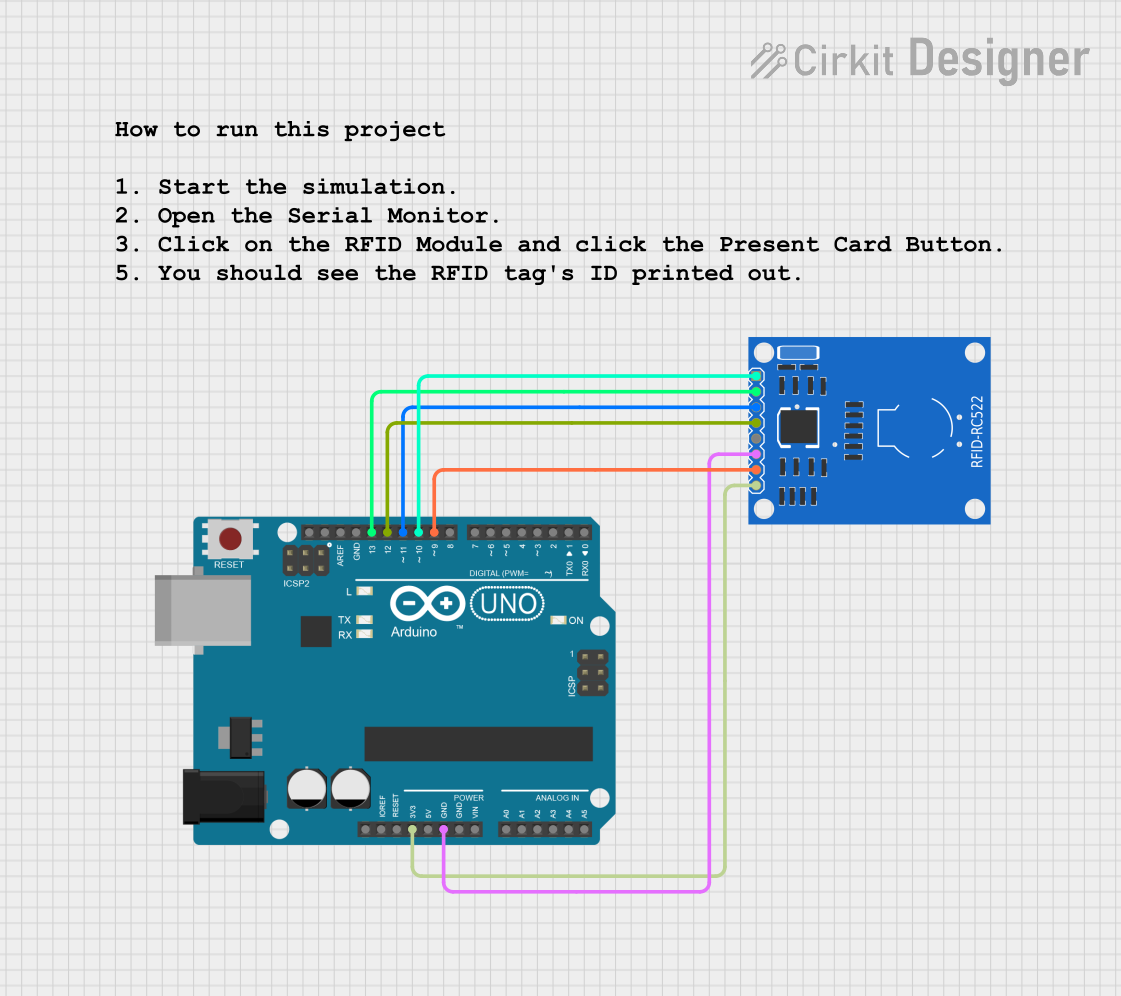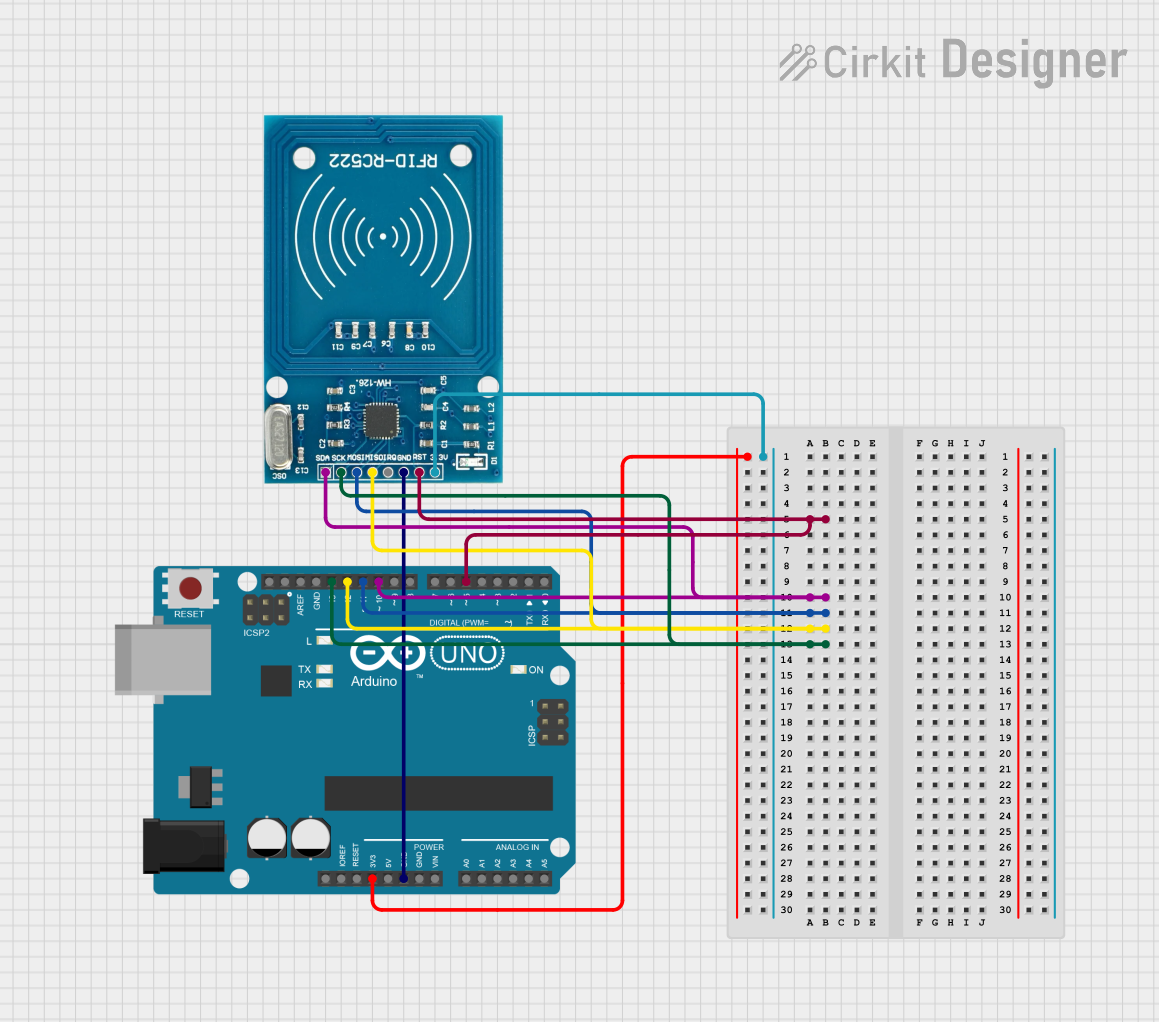
How to Use MFRC522 RFID : Examples, Pinouts, and Specs

 Design with MFRC522 RFID in Cirkit Designer
Design with MFRC522 RFID in Cirkit DesignerIntroduction
The MFRC522 is a highly integrated RFID reader/writer IC that operates at a frequency of 13.56 MHz. It is designed for contactless communication with RFID tags and cards, making it a versatile component for a wide range of applications. The MFRC522 is widely used in systems requiring secure identification, data exchange, or access control. Its compact design and low power consumption make it ideal for embedded systems and portable devices.
Explore Projects Built with MFRC522 RFID

 Open Project in Cirkit Designer
Open Project in Cirkit Designer
 Open Project in Cirkit Designer
Open Project in Cirkit Designer
 Open Project in Cirkit Designer
Open Project in Cirkit Designer
 Open Project in Cirkit Designer
Open Project in Cirkit DesignerExplore Projects Built with MFRC522 RFID

 Open Project in Cirkit Designer
Open Project in Cirkit Designer
 Open Project in Cirkit Designer
Open Project in Cirkit Designer
 Open Project in Cirkit Designer
Open Project in Cirkit Designer
 Open Project in Cirkit Designer
Open Project in Cirkit DesignerCommon Applications
- Access control systems (e.g., door locks, attendance systems)
- Payment systems (e.g., contactless credit card readers)
- Inventory and asset management
- Smart vending machines
- Embedded systems requiring RFID communication
Technical Specifications
Key Technical Details
| Parameter | Value |
|---|---|
| Operating Frequency | 13.56 MHz |
| Operating Voltage | 2.5V to 3.3V (logic level) |
| Supply Voltage (VCC) | 3.3V |
| Current Consumption | 13-26 mA (typical) |
| Communication Interface | SPI, I2C, UART |
| Maximum Data Rate | 424 kbit/s |
| Supported Protocols | ISO/IEC 14443 A/MIFARE |
| Operating Temperature | -20°C to +85°C |
| Dimensions | 40mm x 60mm (module size) |
Pin Configuration and Descriptions
The MFRC522 module typically comes with an 8-pin header for interfacing. Below is the pinout:
| Pin Name | Pin Number | Description |
|---|---|---|
| VCC | 1 | Power supply input (3.3V) |
| RST | 2 | Reset pin (active LOW) |
| GND | 3 | Ground connection |
| IRQ | 4 | Interrupt pin (optional, not always used) |
| MISO | 5 | SPI Master-In-Slave-Out (data output) |
| MOSI | 6 | SPI Master-Out-Slave-In (data input) |
| SCK | 7 | SPI Clock |
| SDA/SS | 8 | SPI Slave Select (chip select) |
Usage Instructions
How to Use the MFRC522 in a Circuit
- Power Supply: Connect the VCC pin to a 3.3V power source and the GND pin to ground.
- SPI Communication: Connect the SPI pins (MISO, MOSI, SCK, and SDA/SS) to the corresponding pins on your microcontroller. Ensure the microcontroller operates at 3.3V logic levels or use a level shifter if necessary.
- Reset Pin: Connect the RST pin to a GPIO pin on the microcontroller for resetting the module.
- Interrupt Pin: The IRQ pin is optional and can be used for advanced interrupt-driven applications.
Important Considerations
- Voltage Levels: The MFRC522 operates at 3.3V. If your microcontroller uses 5V logic, use a level shifter to avoid damaging the module.
- Antenna Placement: Ensure the onboard antenna is not obstructed by metal objects, as this can interfere with RFID communication.
- Tag Distance: The effective reading distance is typically 2-5 cm, depending on the tag and environmental conditions.
Example Code for Arduino UNO
Below is an example of how to use the MFRC522 with an Arduino UNO to read RFID tags. This code uses the popular MFRC522 library.
#include <SPI.h>
#include <MFRC522.h>
// Define MFRC522 pins
#define RST_PIN 9 // Reset pin connected to Arduino pin 9
#define SS_PIN 10 // Slave Select pin connected to Arduino pin 10
MFRC522 rfid(SS_PIN, RST_PIN); // Create an instance of the MFRC522 class
void setup() {
Serial.begin(9600); // Initialize serial communication
SPI.begin(); // Initialize SPI bus
rfid.PCD_Init(); // Initialize the MFRC522 module
Serial.println("Place your RFID card near the reader...");
}
void loop() {
// Check if a new card is present
if (!rfid.PICC_IsNewCardPresent()) {
return; // Exit if no card is detected
}
// Check if the card can be read
if (!rfid.PICC_ReadCardSerial()) {
return; // Exit if the card cannot be read
}
// Print the UID of the card
Serial.print("Card UID: ");
for (byte i = 0; i < rfid.uid.size; i++) {
Serial.print(rfid.uid.uidByte[i], HEX); // Print each byte in hexadecimal
Serial.print(" ");
}
Serial.println();
// Halt the card to stop communication
rfid.PICC_HaltA();
}
Notes on the Code
- Install the
MFRC522library from the Arduino Library Manager before running the code. - Ensure the
SS_PINandRST_PINdefinitions match your wiring.
Troubleshooting and FAQs
Common Issues
Module Not Responding:
- Ensure the module is powered with 3.3V and all connections are secure.
- Verify that the SPI pins are correctly connected to the microcontroller.
Card Not Detected:
- Check the distance between the card and the antenna. It should be within 2-5 cm.
- Ensure there are no metal objects near the antenna that could cause interference.
Incorrect UID Read:
- Verify that the SPI communication speed is set correctly in the microcontroller.
- Ensure the RFID tag/card is compatible with the MFRC522 (e.g., MIFARE cards).
Tips for Troubleshooting
- Use a multimeter to check the voltage levels on the module's pins.
- Test the module with a known working RFID tag to rule out compatibility issues.
- If using a 5V microcontroller, double-check the level shifter connections.
FAQs
Q: Can the MFRC522 read NFC tags?
A: The MFRC522 supports ISO/IEC 14443 A/MIFARE protocols, which are compatible with many NFC tags. However, it does not support all NFC standards.
Q: What is the maximum range of the MFRC522?
A: The typical range is 2-5 cm, depending on the tag and environmental conditions.
Q: Can I use the MFRC522 with a 5V microcontroller?
A: Yes, but you must use a level shifter to convert the 5V logic levels to 3.3V to avoid damaging the module.